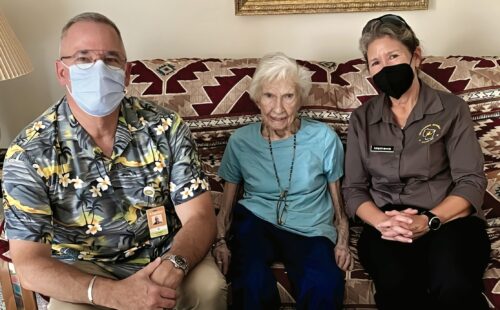John Cornhoff, an 87-year-old World War II Veteran dying of end-stage dementia and pneumonia, is surrounded by several generations of his family, from children to a great-grandchild. Those not present in person have been brought in by speakerphone. Hospice staff members join them for a quality-of-life meeting. “We gather like this to be with you and hear what’s on your hearts and minds. We don’t have an agenda,” Deborah Grassman (VA hospice nurse practitioner) begins.
In accordance with his expressed wishes, John’s boisterous, obviously loving family recently made the decision not to have a tube inserted through his nose into his stomach for artificial nutrition and hydration. Grassman suggests that their decision may be helping him to die more peacefully. She points out that he now seems to be turning inward, a sign of approaching death. “The body has its own wisdom,” she says. “We’re just honoring what’s happening to John, a very holy process to which we want to bring dignity.”
Each of John’s assembled loved ones speaks in turn to reminisce and say goodbye with a mixture of laughter and tears.
“Dad has always lived life to the fullest,” says older daughter Peggy, who sits on her father’s bed to be near him. “He taught us to enjoy life and each other. He accepts people the way they are. We go forward, we don’t go backward.”
Over the speakerphone, son-in-law Tom asks, “Are you listening to this, Dad?” Eyes closed, mouth open, laboring over eachbreath, head bent on the pillow, John nods perceptibly. Someone describes this to Tom, who jokes, “Can I have the ten bucks you owe me?”
This story is featured in VA Transforms End-of-Life Care for Veterans.
More from our blog

Improving Hospice Care for Terminally-Ill Veterans in VA-Contracted Community Nursing Homes
WHV and VA's collaboration on the Community Nursing Home Initiative produced a number of insights that hospice providers can employ to improve education to VA-paid community nursing homes.

Veteran Volunteer Arranges Meeting Between 99-Year-Old Veteran Hospice Patient and the Brigadier General she Admires
AJ Feucht, a Veteran hospice volunteer, connects 99-year-old Veteran hospice patient with Brigadier General Joni Matthews in an act of Veteran comradery!

NHPCO Call for Applicants: 2024 We Honor Veterans Outstanding Program Award
Level 4 & 5 WHV partners with active NHPCO membership are invited to apply for the 2024 WHV Outstanding Program Award!



